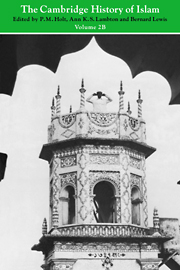Book contents
- Frontmatter
- Introduction
- PART VIII ISLAMIC SOCIETY AND CIVILIZATION
- 1 THE GEOGRAPHICAL SETTING
- 2 THE SOURCES OF ISLAMIC CIVILIZATION
- 3 ECONOMY, SOCIETY, INSTITUTIONS
- 4 LAW AND JUSTICE
- 5 RELIGION AND CULTURE
- 6 MYSTICISM
- 7 REVIVAL AND REFORM IN ISLAM
- 8 LITERATURE
- 9 ART AND ARCHITECTURE
- 10 SCIENCE
- 11 PHILOSOPHY
- 12 WARFARE
- 13 THE TRANSMISSION OF LEARNING AND LITERARY INFLUENCES TO WESTERN EUROPEo
- Dynastic List
- Bibliography
- Glossary
- Index
- References
3 - ECONOMY, SOCIETY, INSTITUTIONS
from PART VIII - ISLAMIC SOCIETY AND CIVILIZATION
Published online by Cambridge University Press: 28 March 2008
- Frontmatter
- Introduction
- PART VIII ISLAMIC SOCIETY AND CIVILIZATION
- 1 THE GEOGRAPHICAL SETTING
- 2 THE SOURCES OF ISLAMIC CIVILIZATION
- 3 ECONOMY, SOCIETY, INSTITUTIONS
- 4 LAW AND JUSTICE
- 5 RELIGION AND CULTURE
- 6 MYSTICISM
- 7 REVIVAL AND REFORM IN ISLAM
- 8 LITERATURE
- 9 ART AND ARCHITECTURE
- 10 SCIENCE
- 11 PHILOSOPHY
- 12 WARFARE
- 13 THE TRANSMISSION OF LEARNING AND LITERARY INFLUENCES TO WESTERN EUROPEo
- Dynastic List
- Bibliography
- Glossary
- Index
- References
Summary
In the vast empire conquered by the Arabs, it is true that the different regions were later to develop or retain their own more or less pronounced characteristics, but, for all that, they were to be not less deeply marked by the unifying imprint of Islam. However, to appreciate the even greater complexity of Muslim society than of Islam considered as a religion, it is important to understand from the outset that both alike resulted from the increasing symbiosis between the conquerors and the original inhabitants, that they preserved a continuity with the traditions of the latter just as much as with those of the former, and that the coming of the new régime did not bring any real social break with the immediate past. Arab immigration into neighbouring territories to the north of their peninsula had started many centuries before Muhammad, and the conquest, if it extended this process, did not modify all the basic factors as much as one might be led to believe—far less than the Germanic invasions modified European society. It occurred in two different forms, bedouin immigration and military colonization, certain features of which must be carefully defined.
To understand these correctly, it must be borne in mind that the settlement of immigrants was generally effected on the basis of a distinction between indigenous private properties, the owners of which remained on them to ensure the maintenance of cultivation and which were respected, and domains of the former states, with the addition of private properties whose owners had been killed or had fled, and which were distributed as emphyteutic concessions (qatī‘a plur., qatā’i‘) to Arab notables who were responsible for their development.
Keywords
- Type
- Chapter
- Information
- The Cambridge History of Islam , pp. 511 - 538Publisher: Cambridge University PressPrint publication year: 1977
References
- 4
- Cited by

